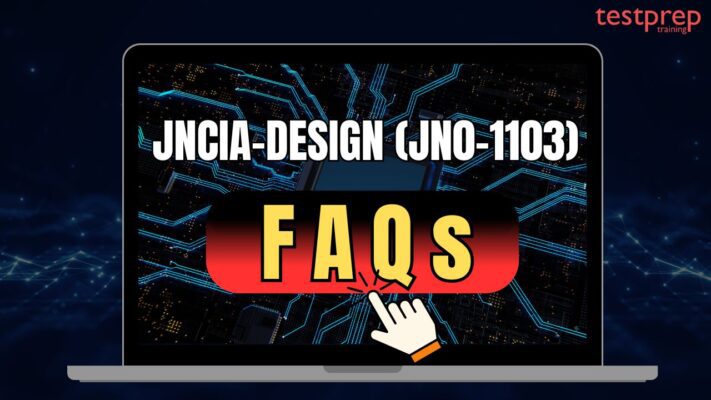JNCIA-Design (JN0-1103)
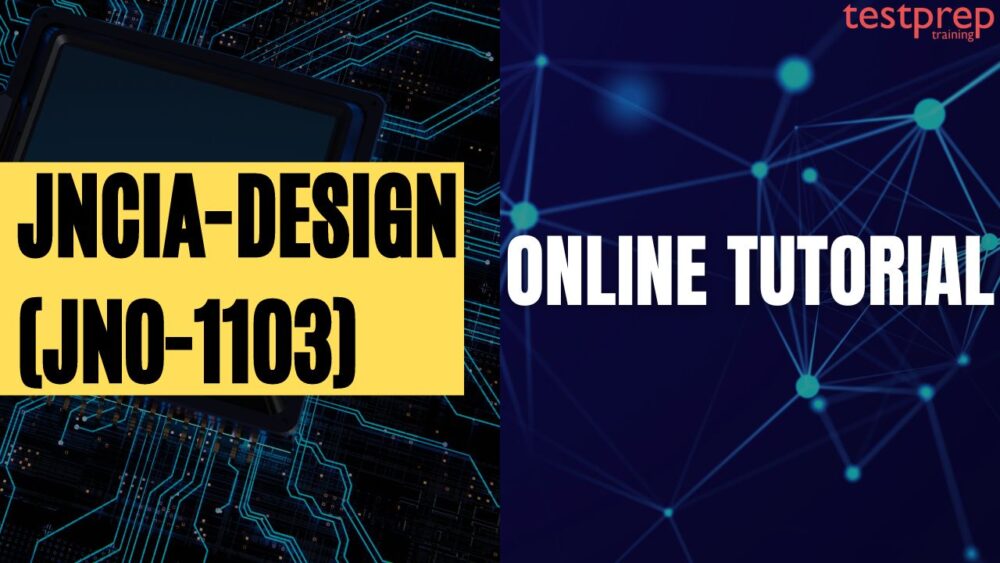
The JNCIA-Design certification, aimed at the associate level, is intended for networking professionals and designers who have basic knowledge of network design principles, theory, and best practices. The written exam assesses your understanding of essential network design concepts.
Target Audience:
The target audience for the JNCIA-Design (JN0-1103) exam is IT professionals who are interested in gaining a foundational understanding of designing and deploying enterprise networks using Juniper Networks products. This includes:
- Network professionals with basic networking knowledge
- Individuals seeking a vendor-neutral foundation in network design
Exam Details
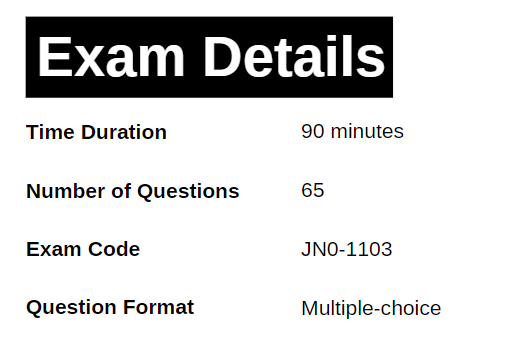
The JNCIA-Design (JN0-1103) certification exam has no prerequisite and is administered by Pearson VUE. It has a time limit of 90 minutes and consists of 65 multiple-choice questions.
Course Outline
The JNCIA-Design (JN0-1103) certification exam covers the following topics:
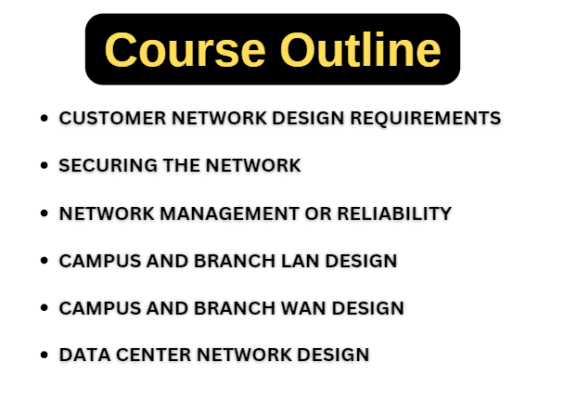
Domain 1: Customer Network Design Requirements
Identify initial network design requirements for:
- Juniper Networks life-cycle service approach
- Proposal boundaries and considerations
- Greenfield and brownfield deployments
- Top-down networks
- Capacity planning
Identify the roles of different Juniper products and solutions, including:
- Routers
- Switches
- Security
- WLAN
- Software-defined networking (SDN)
- Network management
Domain 2: Securing the Network
Identify security design principles for:
- General security design and considerations
- Securing a data center
- Securing the campus WAN
- Zero-trust security
- Secure access service edge (SASE)
Domain 3: Network Management or Reliability
Identify network design considerations for business continuity, including:
- High-resiliency design
- Link- and device-level redundancy
- Multihomed Ethernet Segment Identifier Link Aggregation Groups (ESI LAGs)
- Juniper Networks SRX Firewalls redundancy
- Virtual chassis
- Campus redundancy best practices
Identify design considerations for network automation, including:
- Benefits of network automation
- Juniper automation products
- Junos XML, Representational State Transfer (REST), JSD APIs
- Junos OS on-box and off-box automation
Identify design considerations for network management strategies, including:
- Network management methodologies
- Separation of production and management traffic
- Configuration backups
- Remote console access
- Juniper network management strategies
Domain 4: Campus and Branch LAN Design
Identify considerations for a wired campus or branch LAN, including:
- Campus LAN design best practices
- Modular design
- Subnet and VLAN design
- Access control design
- Ethernet VPN-Virtual Extensible LAN (EVPN-VXLAN) architecture
- Campus oversubscription ratios
- Campus design architectures
Identify considerations for a wireless LAN, including:
- WLAN design phases
- Gathering business requirements
- Gathering technical requirements
- Device types
- Designing secondary coverage
- Designing real-time location services
- Access point (AP) coverage patterns
- Co-channel contention
- Gathering RF requirements
- RF modeling
Domain 5: Campus and Branch WAN Design
Identify considerations for a campus or branch WAN, including:
- Campus or branch WAN connectivity functions
- Best practices for designing the campus or branch WAN
- Campus WAN performance
- Campus WAN VPN design
- Campus active/active and active/passive high availability (HA)
Identify considerations for an SD-WAN, including:
- SD-WAN design considerations
- SD-WAN devices
- Assurance models
- SD-WAN intersite connectivity
Domain 6: Data Center Network Design
Identify considerations for general data center network, including:
- Data center design best practices
- Traffic patterns
- Virtual chassis
- Environmental considerations
- Data center fabric architectures
Identify considerations for IP fabric-based data center network, including:
- Benefits of IP fabric over other data center architectures
- Design options with IP fabrics
- Spine-and-leaf device placement recommendations
- Underlay and overlay design
- Routing protocol selection
- IP fabric best practices
- IP fabric scaling
Exam FAQs: JNCIA-Design (JN0-1103)
Exam General Guidelines
To maintain the high standards of JNCP certifications and ensure the ongoing relevance of certified individuals’ skills, Juniper Networks has established recertification criteria. These criteria are applicable across all JNCP certification tracks and are subject to potential revisions.
- Renewing certifications can be achieved by either passing an exam or completing a course at a higher level within the same track. This renewal also extends to all lower-level active certifications within the track, as well as any other active Associate-level certifications.
- Program participants have access to their certification status through CertMetrics and will receive periodic email notifications concerning their certifications. It is the responsibility of certification holders to keep both their certifications and contact information current.
- All JNCP certifications remain active for three years. Failure to renew certifications within this three-year period will result in their expiration.
Study Guide for JNCIA-Design (JN0-1103)
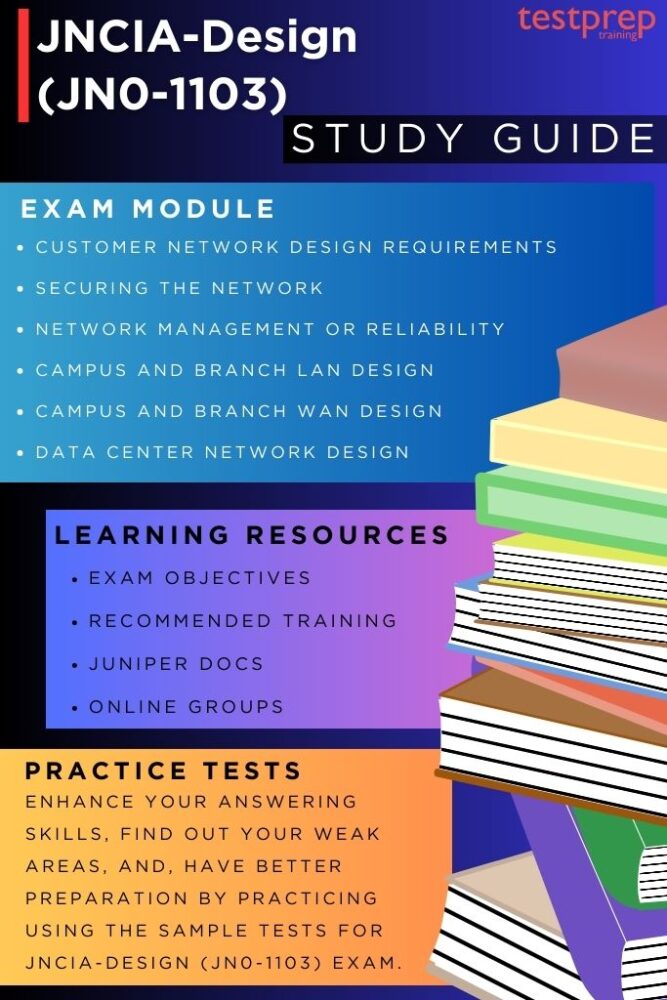
1. Understand the Exam Objectives
Understanding the JNCIA-Design (JN0-1103) exam objectives is essential for effective exam preparation. These objectives specify the topics and skills that will be tested, giving candidates a clear guide for their study efforts. By reviewing these objectives, candidates can pinpoint areas needing more focus, enabling them to create a targeted study plan and use their time and resources wisely. Additionally, familiarizing themselves with the exam objectives helps candidates evaluate their readiness and confidence, ensuring they have covered all necessary topics and are well-prepared for the exam.
2. Use Juniper Recommended Training
Juniper Networks Design Fundamentals:
This three-day course aims to provide a comprehensive overview of fundamental best practices, theoretical foundations, and design principles essential for effective network design. It covers essential topics such as basic network design principles, along with introductory concepts for designing data centers, enterprise WANs, wireless LANs (WLANs), software-defined WANs (SD-WANs), security protocols, network management, and network automation. Additionally, the course addresses key concepts like creating Requests for Proposal (RFPs) and Requests for Information (RFIs), reviewing Juniper products, network migration strategies, IP fabric design, and ensuring business continuity.
3. Use Juniper TechLibrary
Becoming familiar with the Juniper TechLibrary is a vital step toward mastering Juniper Networks technologies. Serving as a comprehensive hub, the TechLibrary houses a wealth of technical documentation, guides, configuration examples, and troubleshooting resources tailored to Juniper products and solutions. Through exploration of the TechLibrary, individuals can delve deeply into the functionalities, configurations, and best practices pertinent to Juniper devices and software. Within this resource, users can explore product documentation, release notes, configuration guides, command references, and troubleshooting articles crafted to cater to their requirements.
4. Join Study Groups
Participating in study groups or communities offers a valuable chance to enhance your learning journey. Joining groups or communities aligned with your interests or certification goals allows you to actively engage in discussions, share ideas, and acquire insights from peers. Moreover, you can benefit from diverse perspectives and expertise shared by other members. These communities provide a supportive environment where individuals offer mutual assistance, encouragement, and guidance to one another.
5. Take Practice Tests
Practicing with tests for the JNCIA-Design (JN0-1103) exam offers benefits as it helps you identify both your strengths and areas needing improvement. This assessment enhances your ability to efficiently handlee questions, which can improve your time management skills for the actual exam. It’s recommended to take these practice tests after finishing each topic to reinforce your understanding of the study materials.


